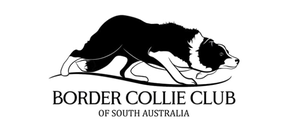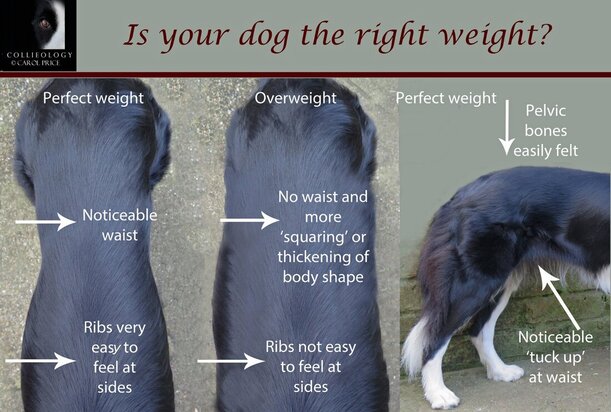THE GREAT WEIGHT DEBATE

We are often asked, 'what is the ideal weight for a Border Collie?'
Our answer first and foremost is that the number on the scales is not the best indicator for your dog's health - let's shift our focus from comparing weight as a number, to overall body condition instead.
Being told your dog is underweight or overweight can be an emotional time for an owner, because we often equate it with the 'body-shaming', embarrassing feeling of hearing it as a human, or that we are being told we are irresponsible, unfit owners. Our dogs, on the other hand, are not offended. They simply rely on us to ensure that we are taking the best care of them that we can, which includes keeping them in optimal condition to avoid injury or extra stress on their hearts and joints and allow them to live an active life for as long as possible. Since we are the ones who control what they eat and when they eat it, we are the ones best placed to control and either avoid or work to rectify weight issues.
Competition or working dogs are often deliberately kept in a leaner condition to ensure minimal impact on their joints through the frequent high impact and higher intensity activities they are engaged in. Desexing dogs alters the release of hormones which can slow metabolism, meaning that if a dog maintains their normal diet after being desexed they may gain weight. It is important to note that it is not desexing that has caused the weight gain, but the change in metabolic rate vs food intake, also influenced by activity levels and exercise.
Border Collie body conditions can be harder to diagnose by sight given the majority of charts show short haired dogs where bone definition is clear, and many Border Collies have longer coats. To indicate your dog's optimal condition or healthy weight we recommend using feel as well as sight using the following key points:
WAIST, RIBS & PELVIC BONES - Look at your dog from above. You should be able to identify a clear 'waist' between the ribs and hips. When you run your hands lightly along the ribs and across their bottom/hip area, you should be able to feel them easily. If you have to press harder or can feel fat over the ribs, or your dog does not have an easily discernable waist, your dog is likely to be overweight and you can take action to drop a few kilograms. If your dog's ribs or pelvic bones are visibly protruding, they may be underweight and as such investigation can be undertaken to identify any environmental factors such as stress, health factors such as illness, or simply adjust their diet accordingly.
BELLY - Now look at your dog from the side. You should see a clear 'tuck up' where their belly tapers at an angle from their ribs up to their groin area. If their belly sags down or you can not see or feel (a big one to remember given some coats can be so big - use your hands!) a defined 'tuck up', then that is again an indicator that your dog is likely to be overweight. Please keep in mind, that overweight dogs are becoming so common that overweight can actually appear more normal to people, and many owners of ideal weight Border Collies have been told that their dogs are underweight by well-meaning onlookers. The below graphic is an excellent reference and will hopefully set some minds at ease with regard to their dog's condition and be an easy point of reference when trying to get a dog to a healthy weight.
Our answer first and foremost is that the number on the scales is not the best indicator for your dog's health - let's shift our focus from comparing weight as a number, to overall body condition instead.
Being told your dog is underweight or overweight can be an emotional time for an owner, because we often equate it with the 'body-shaming', embarrassing feeling of hearing it as a human, or that we are being told we are irresponsible, unfit owners. Our dogs, on the other hand, are not offended. They simply rely on us to ensure that we are taking the best care of them that we can, which includes keeping them in optimal condition to avoid injury or extra stress on their hearts and joints and allow them to live an active life for as long as possible. Since we are the ones who control what they eat and when they eat it, we are the ones best placed to control and either avoid or work to rectify weight issues.
Competition or working dogs are often deliberately kept in a leaner condition to ensure minimal impact on their joints through the frequent high impact and higher intensity activities they are engaged in. Desexing dogs alters the release of hormones which can slow metabolism, meaning that if a dog maintains their normal diet after being desexed they may gain weight. It is important to note that it is not desexing that has caused the weight gain, but the change in metabolic rate vs food intake, also influenced by activity levels and exercise.
Border Collie body conditions can be harder to diagnose by sight given the majority of charts show short haired dogs where bone definition is clear, and many Border Collies have longer coats. To indicate your dog's optimal condition or healthy weight we recommend using feel as well as sight using the following key points:
WAIST, RIBS & PELVIC BONES - Look at your dog from above. You should be able to identify a clear 'waist' between the ribs and hips. When you run your hands lightly along the ribs and across their bottom/hip area, you should be able to feel them easily. If you have to press harder or can feel fat over the ribs, or your dog does not have an easily discernable waist, your dog is likely to be overweight and you can take action to drop a few kilograms. If your dog's ribs or pelvic bones are visibly protruding, they may be underweight and as such investigation can be undertaken to identify any environmental factors such as stress, health factors such as illness, or simply adjust their diet accordingly.
BELLY - Now look at your dog from the side. You should see a clear 'tuck up' where their belly tapers at an angle from their ribs up to their groin area. If their belly sags down or you can not see or feel (a big one to remember given some coats can be so big - use your hands!) a defined 'tuck up', then that is again an indicator that your dog is likely to be overweight. Please keep in mind, that overweight dogs are becoming so common that overweight can actually appear more normal to people, and many owners of ideal weight Border Collies have been told that their dogs are underweight by well-meaning onlookers. The below graphic is an excellent reference and will hopefully set some minds at ease with regard to their dog's condition and be an easy point of reference when trying to get a dog to a healthy weight.

